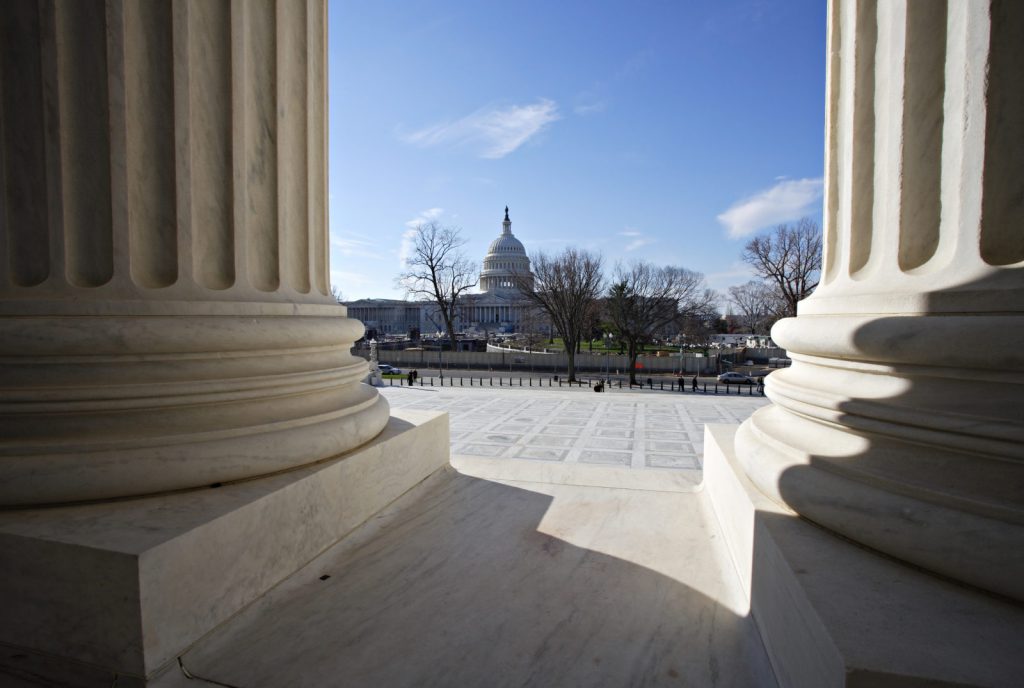
Published January 5, 2018
National Review - January 22, 2018 issue
Donald Trump deserves thunderous acclaim from conservatives for his outstanding record of judicial appointments during his first year as president. But his conspicuous successes should not obscure the many obstacles on the long path to genuine transformation of the federal judiciary. Those obstacles have seriously impeded judicial confirmations and threaten to continue to do so. But if they are cleared or eluded, and if Republicans retain control of the Senate after the 2018 elections, President Trump will be positioned to make a huge enduring impact on the courts during his first term.
Trump’s most important achievement on the judicial front in 2017 was his appointment of Supreme Court justice Neil Gorsuch to fill the vacancy left by Antonin Scalia’s death in February 2016. That appointment consummated Senate Republican leader Mitch McConnell’s strategy of keeping the vacancy open through the 2016 presidential election, and it resoundingly vindicated the wisdom of that strategy. Even better, the Senate Democrats’ foolish obstruction of the Gorsuch nomination on the Senate floor drove Senate Republicans to abolish the filibuster (the 60-vote threshold for cloture) for Supreme Court nominations. So, when the next Supreme Court vacancy arises, the White House will have the benefit of knowing from the outset that it needs the support of only 50 senators, together with the tie-breaking vote of Vice President Mike Pence, to secure the confirmation of its nominee.
In 2017, President Trump also appointed twelve federal appellate judges — a record for a president in his first year in office. (President Obama appointed three federal appellate judges in his first year and 55 over his eight years.) Beyond their number, Trump’s appellate appointees have, on the whole, outstanding credentials and are highly regarded in conservative legal circles. Indeed, six of the twelve have already earned their way onto Trump’s list of Supreme Court candidates. The twelve include three women — Amy Coney Barrett, a former Scalia clerk who was a professor of law at Notre Dame; Joan Larsen, also a former Scalia clerk and a Michigan supreme-court justice; and Allison Eid, who clerked for Justice Thomas and served on the Colorado supreme court for eleven years. They also include two Asian Americans, Amul Thapar, a Bush 43 appointee to a federal district-court judgeship, and James Ho, a distinguished appellate lawyer who was also a Thomas clerk.
Three factors account for this remarkable success on federal appellate judges. First, the conservative legal movement has grown significantly over the past two decades. In 2001, the George W. Bush White House would have had to search long and hard to find highly credentialed judicial conservatives for some vacancies. Sixteen years later, the pipeline is bursting with superb candidates whose legal training, whether in law school or on the job, has been deeply influenced by Justices Scalia and Thomas and by the Federalist Society. Indeed, two federal appellate nominations in Texas were delayed for months not by the inability to find suitable candidates but by the challenge of deciding among so many.
Second, thank Harry Reid. In November 2013, the Democratic majority leader pushed to repeal the filibuster for lower-court (and executive-branch) nominees. His success meant that a steadfast minority of 41 or more senators could no longer block a judicial nomination. So, when the president and the Senate are of the same party, the path to confirmation can be fairly certain and quick. Further, that promise of a smooth path encouraged high-quality conservatives — the very folks who might reasonably have feared a filibuster and been most reluctant to put their careers in indefinite limbo — to offer themselves as candidates. With the filibuster abolished, the time from nomination to confirmation for the twelve federal appellate judges ranged from two to six months.
Third, federal appellate nominations mattered deeply to the key players. Kudos to President Trump and White House counsel Don McGahn for selecting excellent nominees, and to Mitch McConnell and Senate Judiciary Committee chairman Chuck Grassley for placing a high priority on moving them through to confirmation.
For all the justified celebration of Justice Gorsuch and these twelve new appellate judges, however, the overall picture on judicial confirmations is far from rosy. Seven vacancies on the courts of appeals have gone nearly a year without any nomination being made to fill them. The situation on district-court nominations is much worse (and has very little to do with the three recently withdrawn nominations that caused the Trump administration some embarrassment). Only six district judges were confirmed in 2017. Twenty-two nominations were left languishing on the Senate floor at the end of the year, including twelve that had been awaiting action since October. And dozens of district-court vacancies that existed on Inauguration Day still await nominees.
Two big obstacles — one at the front end of the nomination process, the other at the back end — have caused these impasses and threaten to continue to stymie judicial confirmations. The front-end obstacle is the Senate Judiciary Committee’s so-called blue-slip privilege, which accords individual senators the opportunity to approve or disapprove of judicial nominees in their home states (and which derives its name from the piece of paper that senators once used to register their views). Judiciary Committee chairmen in recent decades have varied on whether a negative blue slip flatly blocks a nominee. But the very existence of the privilege encourages the White House to consult about potential nominees with home-state senators of both parties.
Given the stark divide on judicial philosophy between the White House and Senate Democrats, not to mention the animosity between them, it’s no surprise that the consultations that the White House has undertaken on judicial nominations have yielded little fruit. As Christmas approached, there were 39 district-court vacancies — 26 existing on Inauguration Day — in “blue-senator” states (i.e., states with two Democratic senators), and there were an additional 31 vacancies in “purple-senator” states (those with one Democratic senator). Of those 70 vacancies, nominations had been made for only two (until, just days before Christmas, an additional nine nominations were made).
The situation is similar, if somewhat less stark, for federal appellate nominees. Only one of the twelve confirmed judges is in a blue-senator state (Michigan, which Trump won). Of the nine appellate vacancies that have existed for more than three months and that don’t yet have a nominee, seven are in blue-senator states.
Fortunately for President Trump, Chairman Grassley has recently clarified that he will not treat a negative blue slip as a veto. In November — on the same day, as it happens, as the first report of Senator Al Franken’s alleged acts of sexual abuse — Grassley announced that he would not defer to Franken’s negative blue slip of David Stras, the highly respected Minnesota supreme-court justice who was nominated in May to a federal appellate seat. “I won’t allow senators to block nominees for political or ideological reasons,” said Grassley. So long as the White House has consulted with the home-state senators, the Judiciary Committee will hold a hearing on a nomination and vote on whether to report it to the Senate floor.
Grassley’s newly clarified blue-slip policy ought to encourage the White House to make nominations in blue and purple states. But nominees who lack a Senate backer will likely find themselves near the back of the confirmation line. That line may prove long and slow because of the back-end obstacle that nominees face: the Senate’s arcane and cumbersome “cloture” process.
No vote can take place in the Senate on any bill, amendment, or nomination unless there has first been agreement to end debate on the particular matter. In the ordinary course, the Senate routinely proceeds to merits votes by the unanimous consent of its members. But if a single member persists in withholding consent, the procedure for ending debate is a cloture motion. Two business days after the filing of a cloture motion, the Senate votes on that motion. If the motion is successful, further debate on the matter can continue for up to 30 floor hours, during which time no other merits votes can occur. Cloture motions can thus seriously disrupt and delay the ordinary work of the Senate.
For most of the Senate’s history, cloture motions on judicial nominations have rarely been necessary. That changed when Senate Democrats launched their unprecedented campaign of partisan filibusters against George W. Bush’s judicial nominees. Senate Republicans filed cloture motions in response. When they controlled the Senate during the Obama presidency, Democrats did likewise with respect to the smaller number of judicial nominees facing a Republican filibuster. In addition, Harry Reid adopted the practice of filing a cloture motion on nearly every nominee (and of pretending that every cloture motion was evidence of a Republican filibuster).
Even though the 60-vote threshold for cloture on nominations has been abolished, the cloture process — now with a simple-majority requirement — continues to apply to nominations. During the Trump presidency, Democrats have routinely required cloture votes for executive-branch and judicial nominations — 66 in total in 2017, including votes on all but one confirmed judicial nominee. They are doing so for the primary purpose of chewing up scarce time on the Senate floor and thus limiting the pace at which nominees can be confirmed.
The Senate’s executive calendar at year end had over 100 nominations (executive and judicial) awaiting a Senate vote. If Senate Republicans are going to keep the judicial-confirmation process moving, they will need to find a way to put an end to the Democrats’ gamesmanship on cloture.
Democrat Doug Jones’s victory in the Senate race in Alabama last month also complicates the picture. The Republican margin in the Senate is now down to 51–49, so the White House has little room for error. Democrats will look for opportunities to pick off the two Republicans needed to defeat a nomination.
Even worse, Jones’s victory means that control of the Senate is very much up for grabs in the November 2018 election. A year ago, continued Republican control of the Senate seemed a very safe bet. Indeed, Republicans appeared poised to gain two to four seats. No longer. The White House and Senate Republicans will be racing against the clock to confirm as many judges as possible before the elections, and Senate Democrats will be doing their best to run out the clock. If Democrats do win control of the Senate, judicial confirmations will come to a grinding halt.
If the rumors are true that Justice Anthony Kennedy is inclined to retire, Jones’s victory and the very real risk that Republicans will lose their Senate majority might clinch Kennedy’s decision to step down this spring. If he waits another year and Democrats win control of the Senate in the meantime, his seat would probably remain empty until 2021.
Transforming the lower courts will take sustained progress over years. There are 179 judicial positions across the 13 federal courts of appeals and 673 district judgeships. (The figures exclude the large number of judges who have vacated their seats but who continue to work in senior status.) So Trump’s first-year tally of twelve appellate judges accounts for less than 7 percent of the appellate total, and his six district judges don’t even amount to 1 percent of the district-judge pool.
What’s more, nine of the courts of appeals have a majority of judges appointed by Democratic presidents, some by large margins. On the D.C. Circuit, which has an outsized role in reviewing federal-agency action, Democratic appointees outnumber Republican appointees seven to four. On the notoriously liberal Ninth Circuit, which covers California and eight other western states, the head count is a whopping 18 to six. And the ratio of unsound to sound judges on the appellate courts is, alas, much higher than the ratio of Democratic to Republican appointees.
On the bright side, success begets success. Republican senators know that delivering big on judicial confirmations will help them keep control of the Senate. Further, if the White House continues to show that it can expeditiously fill vacancies with outstanding candidates, sitting Republican appointees who are eligible to retire with full benefits — there are some 30 such judges on the appellate courts right now — will be more likely to step down.
President Trump got off to a great start on judicial confirmations in 2017. Twenty eighteen will go far to determine whether he can turn a great start into a real transformation of the American judiciary.
– Mr. Whelan, the president of the Ethics and Public Policy Center, is a regular contributor to National Review Online’s Bench Memos blog and is the co-editor of Scalia Speaks: Reflections on Law, Faith, and Life Well Lived.












